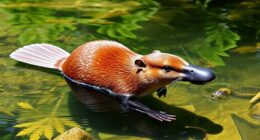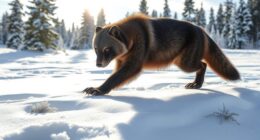Were you aware that hyenas are not just scavengers, but also adept predators? These intriguing animals have a varied diet that covers the African savanna, showcasing their significance in the ecosystem. Join us as we delve into the eating habits of hyenas and unveil their diet secrets.
Key Takeaways:
- Hyenas are versatile eaters, able to both scavenge and hunt for food.
- They consume a wide range of prey, from small birds and mammals to large ungulates like wildebeest and zebras.
- Hyenas have incredibly powerful jaws that allow them to extract valuable nutrients from bones.
- Various hyena species have different dietary preferences and foraging habits.
- Human activity and habitat encroachment pose challenges to hyena populations and conservation efforts.
Spotted Hyena Cuisine
Spotted hyenas, also known as laughing hyenas, are renowned for their exceptional hunting skills and their preference for large ungulates. These cunning predators are capable of taking down wildebeest, zebras, and antelopes with astonishing efficiency. Their ability to work together in highly organized clans makes them one of the most successful and formidable predators on the African savanna.
Spotted hyenas, both males and females, actively participate in hunting, demonstrating their highly developed social cooperation. By working in tandem, they can take on much larger prey, overpowering them with their powerful jaws and relentless determination. The communal nature of their hunting strategy sets them apart from other carnivores, showcasing their superior skills as efficient pack hunters.
“Spotted hyenas are remarkable predators, capable of bringing down large ungulates through strategic teamwork and their formidable hunting abilities,”
At birth, spotted hyena cubs are entirely reliant on their mother’s rich milk. As they grow, their diet gradually transitions to solid foods. This process plays a vital role in the development of the cubs’ hunting techniques and enhances their ability to thrive in the harsh African wilderness.
Spotted hyenas’ preference for large ungulates is not only a testament to their hunting prowess but also highlights their impact on maintaining the balance of the African savanna ecosystem. By controlling the population of these herbivores, they prevent overgrazing and ensure the overall health and vitality of the landscape.
Spotted Hyena Cuisine:
- Large ungulates like wildebeest
- Zebra
- Antelopes
Through their skilled hunting and cooperative nature, spotted hyenas have cemented their position as top predators, shaping the dynamics of their habitat and contributing to the intricate web of life in the African savanna.
Brown Hyena Eating Habits
The elusive brown hyena has a varied diet that includes carrion, fruits, insects, and eggs. They are skilled at using their strong jaws to crush bones and extract nutrients. Unlike spotted hyenas, brown hyenas are more solitary in their foraging habits.
| Food | Description |
|---|---|
| Carrion | The brown hyena feeds on carrion left behind by other predators. They are adept at scavenging and extracting valuable nutrients from carcasses. |
| Fruits | Brown hyenas consume a variety of fruits, including berries and melons, as part of their diet. Fruits provide them with essential vitamins and hydration. |
| Insects | Insects play a significant role in the brown hyena’s diet. They feed on beetles, termites, and other small insects, which are a valuable source of protein. |
| Eggs | These hyenas have the capability to crack open and consume eggs, making them opportunistic predators of nesting birds and reptiles. |
With their diverse food choices, brown hyenas adapt to their environment and ensure they have access to a range of nutrients. Their solitary foraging habits allow them to secure their meals without competition from other hyenas.
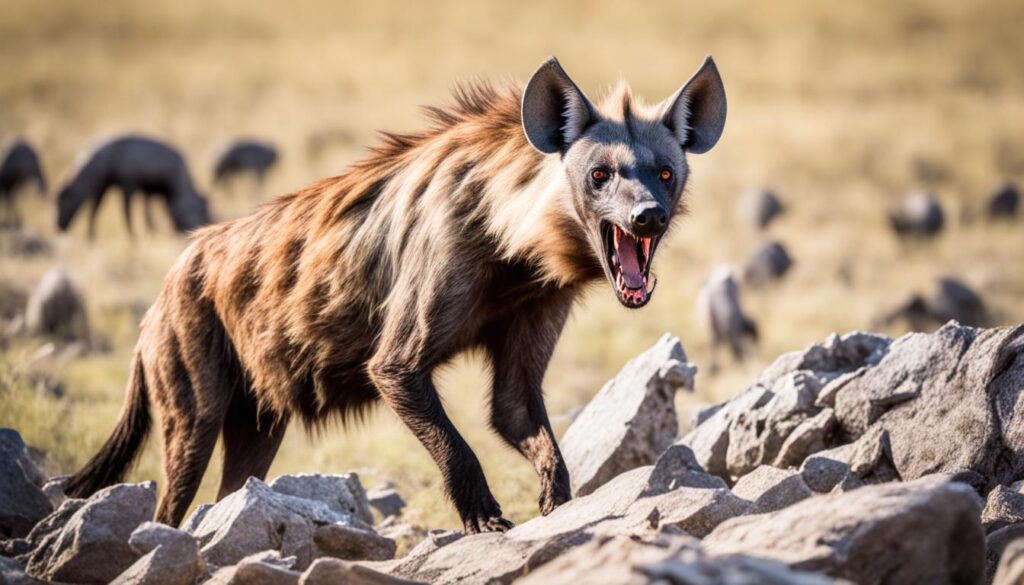
Striped Hyena Feeding Patterns
Striped hyenas are fascinating creatures with unique feeding patterns. As scavengers, they primarily rely on carrion as a source of sustenance. In addition to scavenging, striped hyenas also include a variety of other food items in their diet, such as fruits, insects, and occasionally small mammals and birds. This diverse diet allows them to adapt to different environments and find nourishment in various sources.
Unlike their spotted hyena counterparts, striped hyenas forage alone and do not typically engage in hunting large prey. Instead, they capitalize on the remains left behind by other predators or search for smaller prey that they can capture on their own. This solitary foraging behavior sets them apart and showcases their ability to survive and thrive in different ecosystems.
One of the intriguing aspects of striped hyenas’ feeding habits is their preference for carrion. Their acute sense of smell enables them to detect the scent of decaying flesh from great distances, leading them to carrion sites. This scavenging behavior helps maintain the balance of nature by assisting in the decomposition process and preventing the spread of diseases.
“Striped hyenas possess remarkable adaptations that allow them to survive as efficient scavengers. Their diet consists of a diverse range of food sources, making them flexible and resilient hunters in their own right.”
When carrion is scarce, striped hyenas supplement their diet with fruits, insects, and occasionally small mammals and birds. This opportunistic feeding behavior allows them to capitalize on available resources and ensures their survival in challenging conditions.
To visualize the feeding patterns of striped hyenas, the following table provides a summary of their primary food sources:
| Food Sources | Description |
|---|---|
| Carrion | Remains of animals left by other predators |
| Fruits | Nutrition-rich fruits found in their habitat |
| Insects | Various types of insects, including beetles and ants |
| Small Mammals | Occasionally catch small mammals such as hares or rodents |
| Birds | Opportunistically feed on a variety of bird species |

By utilizing their unique adaptations and resourcefulness, striped hyenas have managed to thrive as scavengers in their respective habitats. Understanding their feeding patterns helps us appreciate the incredible diversity of hyena species and their role in maintaining the ecological balance of their ecosystems.
Aardwolf Diet Specialization
The aardwolf, a unique member of the hyena family, boasts a highly specialized diet that revolves around termites and insects. Unlike its hyena relatives, the aardwolf’s primary source of sustenance is not ungulates or carrion. Instead, it is solely dedicated to consuming these tiny arthropods, making it one of the most specialized insectivores in the animal kingdom.
Equipped with a long, sticky tongue, the aardwolf captures termites and other insects with great precision. Its tongue acts as a formidable tool, allowing it to probe deep into termite mounds and extract its favorite delicacy. This remarkable adaptation enables the aardwolf to forage through termite colonies without causing significant damage to the mounds themselves.
Termites: A Nutritious Feast
Termites, though often dreaded by humans for their destructive capabilities, present a bountiful source of nutrition for the aardwolf. These small insects are rich in protein and other essential nutrients, providing the aardwolf with all the sustenance it needs to thrive.
The aardwolf’s specialized diet showcases the marvels of nature’s adaptations, revealing how a single species can carve out a unique niche to survive and flourish.
As a proficient termite eater, the aardwolf ensures that these insect populations are kept in check. Their feeding habits contribute to the regulation of termite numbers and prevent the overwhelming proliferation of these small yet pivotal creatures.
Aardwolves: Nocturnal Foragers
Aardwolves are primarily nocturnal, venturing out under the cover of darkness to satiate their appetites. Moving stealthily through grasslands and scrublands, they employ their keen sense of smell to locate the hidden corridors and colonies of termites.
Under the moonlit sky, aardwolves meticulously comb through the terrain, meticulously selecting their targets and skillfully capturing the unsuspecting insects. Their highly evolved adaptations enable them to navigate through grasses and detect even the faintest scent trails left by their prey.
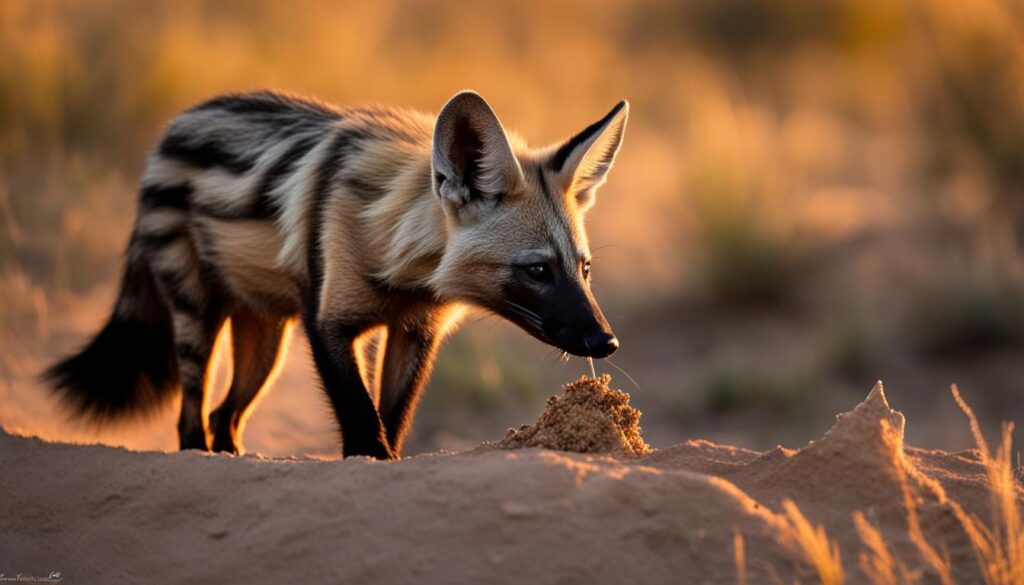
The image above depicts the elegant and elusive aardwolf, showcasing its slender and graceful form as it embarks on its nocturnal hunting expeditions.
The Aardwolf’s Ecological Importance
The aardwolf’s diet specialization and its role as a specialized insectivore contribute to the delicate balance of ecosystems it inhabits. By preying on termites and other insects, aardwolves help control the population of these arthropods, preventing potential damage to vegetation and minimizing the risk of infestations.
Furthermore, aardwolves play a vital part in nutrient cycling. As they consume termites, they acquire and metabolize the nutrients contained within, ultimately redistributing those nutrients through their waste. This process enriches the soil, enhancing its fertility and supporting the health and growth of other plants and organisms within the ecosystem.
The aardwolf’s remarkable adaptation to its specialized diet highlights the incredible diversity of nature and the intricate interplay between organisms and their environment. Its existence serves as a testament to the remarkable and often surprising ways in which species have evolved to thrive in their respective niches.
Hyenas Navigating Human Settlements
Hyenas are remarkably adaptable creatures, and they have found ingenious ways to thrive in human settlements. They take advantage of the abundance of resources available in these areas, particularly the remains of slaughtered animals and other waste materials. This close proximity to humans can result in both commensalism and conflict, with hyenas taking advantage of the easily accessible food sources.
Commensalism refers to a mutually beneficial relationship between two species without causing harm or benefit to the other. In the case of hyenas, their scavenging behavior around human settlements can be seen as a form of commensalism, as they benefit from the abundant food without posing a direct threat to humans.
Hyenas have learned to navigate the complexities of human settlements, capitalizing on the resources provided by our activities, and finding a way to coexist alongside us. It’s a testament to their adaptability and resilience.
However, this close interaction between hyenas and humans can also lead to conflicts, especially when hyenas target livestock. The predation of domestic animals can result in economic losses for local communities and create tension between humans and hyenas.
Furthermore, the diet of hyenas is significantly impacted by the availability of human-related food sources. While hyenas are natural scavengers and hunters, the easy access to human waste can alter their feeding patterns and create dependencies on human settlements for sustenance. This reliance on human-related food sources can have complex implications for hyena populations and poses challenges for conservation efforts.
To better understand the impact of human settlements on hyenas and mitigate potential conflicts, it is crucial to study their diet preferences and behavior in these environments. By analyzing the diet impact and exploring ways to promote coexistence, we can work towards finding sustainable solutions that benefit both hyenas and local communities.
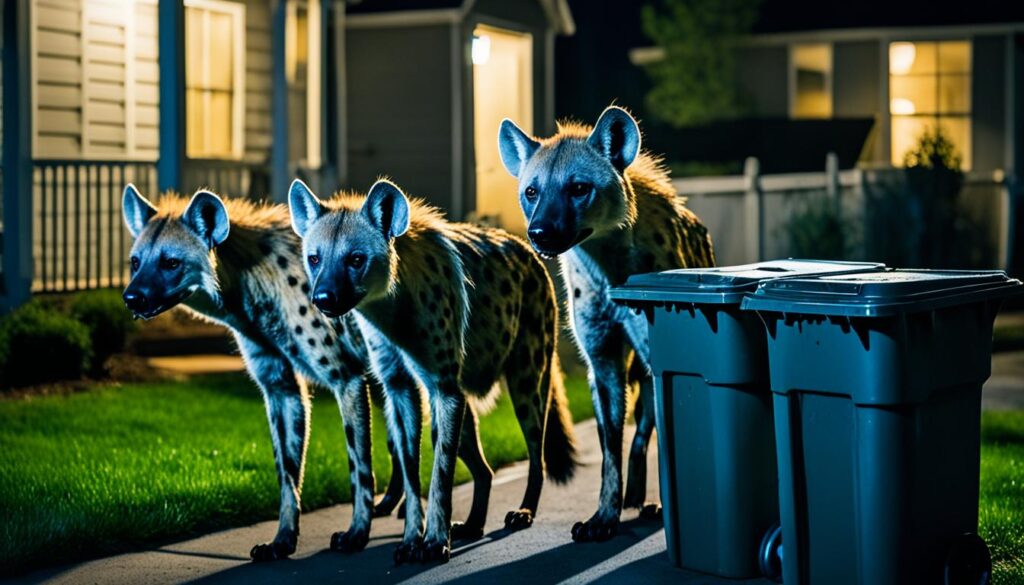
Key Takeaways
- Hyenas have adapted their foraging behavior to thrive in human settlements.
- They take advantage of readily available resources such as remains of slaughtered animals and other waste materials.
- This proximity to humans can lead to both commensalism and conflict.
- The diet of hyenas is significantly impacted by human-related food sources, which can create complex interactions and challenges for conservation.
Conservation Status and Diet
Despite their portrayal in popular media as mere scavengers, hyenas play a crucial role in the ecological framework as both predators and scavengers. They shape dynamics within their habitats, interacting with other large carnivores like lions. However, human activity and encroachment on their habitats not only alter their natural diet but also pose threats to their conservation status. Balancing conservation efforts and managing hyena-human interactions is essential for maintaining healthy ecosystems and safeguarding hyena populations.
The Ecological Role of Hyenas
Hyenas, with their unique diet and feeding habits, have a significant impact on the ecosystems they inhabit. As scavengers, they help clean up carcasses and prevent the spread of diseases. By consuming carrion left by other predators, hyenas play an important role in nutrient recycling, returning valuable resources back into the environment. Additionally, as predators, they regulate herbivore populations and contribute to maintaining a balanced ecosystem.
Hyenas, with their adaptable eating habits, are nature’s garbage disposers, ensuring that nothing goes to waste.
The Threat of Human-Wildlife Conflict
However, human activities such as expanding agricultural land, urbanization, and poaching have drastically impacted hyena populations and their natural diet. Encroachment into hyena habitats disrupts their foraging patterns and can lead to increased competition for resources, exacerbating conflicts between humans and hyenas. This conflict often arises when hyenas target livestock, posing risks to both human livelihoods and hyena conservation.
As human populations grow and expand, finding ways to mitigate human-wildlife conflict becomes crucial for the long-term survival of hyenas and other wildlife species.
Conservation Efforts and Management
To ensure the survival of hyenas and maintain healthy ecosystems, conservation efforts are essential. This includes implementing measures to protect hyena habitats, managing human-wildlife interactions through education and awareness programs, and promoting sustainable practices that minimize conflicts and support coexistence. By understanding the ecological role of hyenas and addressing the root causes of human-wildlife conflict, we can work towards securing a future for these incredible creatures.

| Threats to Conservation | Conservation Strategies |
|---|---|
| Poaching for body parts and fur | Implement stricter enforcement of anti-poaching laws and increase penalties |
| Habitat loss and fragmentation | Establish protected areas and promote reforestation efforts |
| Human-wildlife conflict | Develop community-based conservation initiatives, such as compensation programs and predator-proof enclosures |
| Illegal wildlife trade | Strengthen law enforcement and raise awareness about the negative impacts of the wildlife trade |
Recycling Nutrients with Powerful Jaws
Hyenas possess remarkable jaw strength and bone-crunching abilities that enable them to extract essential calcium and phosphorus from bones. This impressive capability not only aids in their survival but also contributes to nutrient recycling in the environment.
Through their powerful jaws, hyenas efficiently break down bones, extracting valuable nutrients that would otherwise go to waste. The process of bone consumption allows hyenas to recycle calcium and phosphorus back into the ecosystem, promoting overall environmental health.
Interestingly, hyenas’ dung contains significantly higher concentrations of these recycled nutrients compared to the local soils. As hyenas traverse their habitats, their nutrient-rich droppings act as a natural fertilizer, enriching the surrounding soil and facilitating nutrient cycling.
This nutrient recycling process holds particular significance in nutrient-deficient regions like the Kalahari Desert. Hyenas play a vital role in maintaining the delicate balance of nutrient availability in these ecosystems, supporting the survival and well-being of other organisms within their habitats.
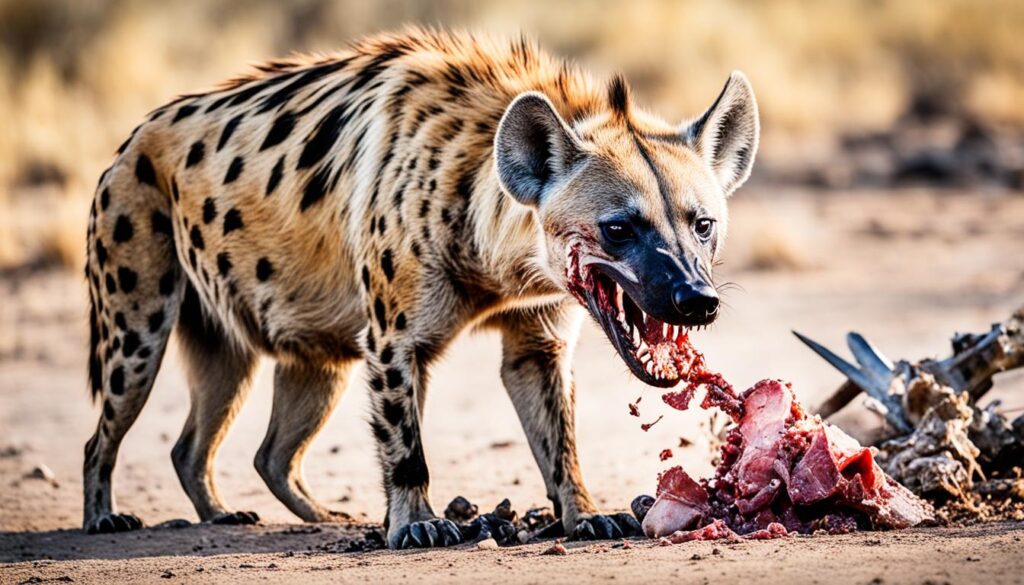
| Nutrient Recycling by Hyenas | Benefits |
|---|---|
| Potent jaw strength | Efficient extraction of calcium and phosphorus from bones |
| Recycled nutrients in hyenas’ dung | Significantly higher concentrations of calcium and phosphorus compared to local soils |
| Fertilization of soil | Nutrient-rich droppings act as natural fertilizer, enriching the environment |
| Support for nutrient-deficient habitats | Crucial role in maintaining nutrient balance in regions like the Kalahari Desert |
Conclusion
Hyenas, with their versatile and adaptable diet, have mastered the art of hunting and scavenging, consuming a wide variety of prey. They are not only formidable predators but also play a vital ecological role in managing ecosystems and preventing the spread of disease. However, human-wildlife conflict and habitat encroachment pose significant threats to hyena populations and conservation efforts.
By understanding the dietary secrets of hyenas and promoting sustainable coexistence, we can work towards protecting these fascinating creatures and preserving the delicate balance of nature. It is crucial to address the challenges of human-wildlife conflict and find ways to minimize the impact on hyena populations while ensuring the conservation of their habitats.
Conservation efforts aimed at preserving hyenas can have far-reaching benefits, not only for these incredible animals but also for the overall health and biodiversity of the ecosystems they inhabit. Through education, awareness, and responsible practices, we can foster a harmonious relationship between humans and hyenas, ensuring their continued survival for generations to come.








